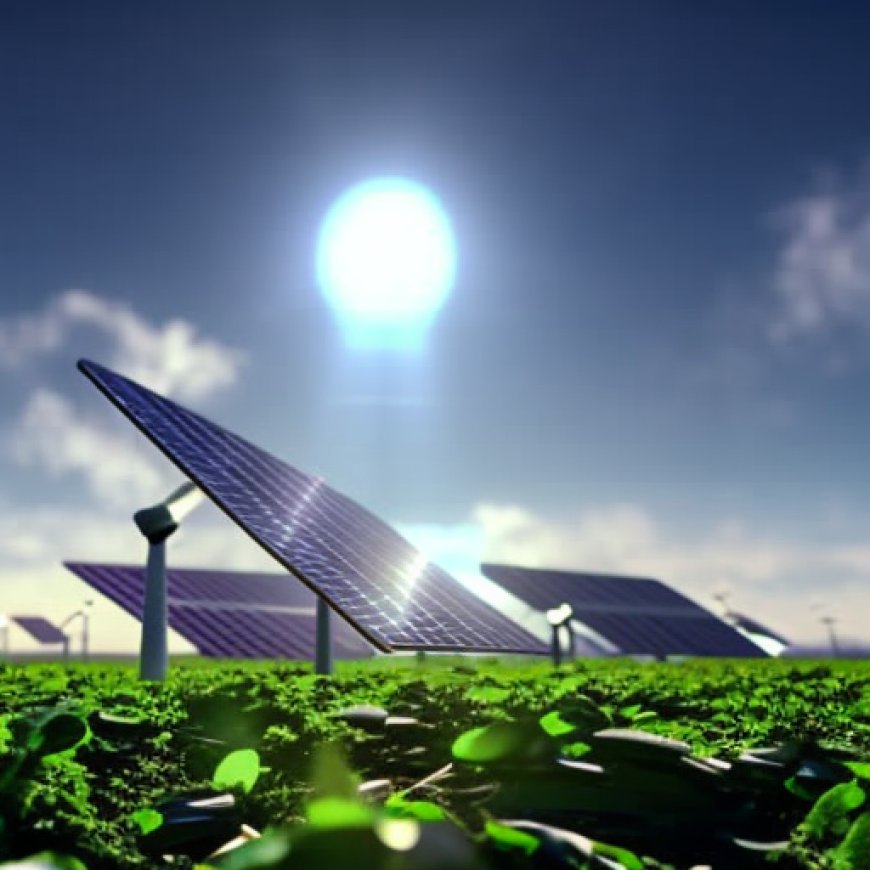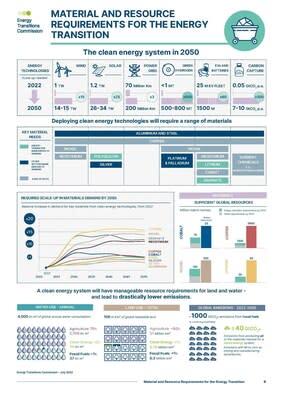Dramatic scale-up of critical materials and resources required for clean technologies this decade – Energy Transitions Commission
Dramatic scale-up of critical materials and resources required for clean technologies this decade - Energy Transitions Commission Yahoo Finance


LONDON, July 20, 2023 /PRNewswire/ — Material and Resource Requirements for the Energy Transition
The Sustainable Development Goals (SDGs) and the Energy Transition
There are more than sufficient natural resources and minerals to meet the needs of a global zero-carbon energy system, and that system will impose a far smaller environmental impact on the world than today’s fossil fuel-based system. But, as the global Energy Transitions Commission highlights in its latest report, “Material and Resource Requirements for the Energy Transition”, large investments and strong policy support are needed to ensure that the supply of some key minerals grows quickly and sustainably over the next decade to meet rapidly growing demand.


The Future Net Zero Emission Economy
The future net zero emission economy will depend on huge increases in electricity supply and demand, rising from a global total of ~28,000 TWh in 2022 to over ~100,000 TWh by 2050. This will require massive deployment of solar and wind power capacity, a major expansion of electricity grids, and huge growth in the production of batteries and electric vehicles and electrolysers for green hydrogen production.
This new energy system will require significant resources of both land (primarily for solar PV farms) and water (used in the power system, carbon capture, and a range of mining and refining processes). But the total land and water requirements are similar to those required by the fossil fuel-based system, and less than 3% of the land and water resources used by global agriculture.
Building the new energy system will also result in some initial CO2 emissions – the first generation of any new clean technology has to be built using fossil fuel-based energy. But the production of materials to support the energy transition will result in total global cumulative life cycle emissions of 15-30 GtCO2e, compared with the ~40 GtCO2e produced every year from the current fossil-fuel-based energy system; and while the former will fall towards zero as the mining and refining sectors decarbonise, emissions from fossil fuels would continue in perpetuity if we do not transition to a new system.
So, while land and water requirements must be managed carefully, particularly in densely populated and water-stressed regions, and while life cycle emissions from material production must be minimised, the key challenges relate to the minerals and other materials required for the energy transition.
The Scale of Materials Needed for the Energy Transition
Between 2022–2050, the energy transition could require the production of 6.5 billion tonnes of end-use materials, 95% of which would be steel, copper, and aluminium, with much smaller quantities of critical minerals/materials such as lithium, cobalt, graphite, or rare earths. This cumulative material extraction compares with the over 8 billion tonnes of coal currently extracted annually.
There is no fundamental shortage of any of the raw materials to support a global transition to a net-zero economy: geological resources exceed the total projected cumulative demand from 2022-50 for all key materials, whether arising from the energy transition or other sectors. The key issues are therefore:
- Ramping up supply fast enough to decarbonize the global economy at the pace required.
- Ensuring mining for key materials occurs in a sustainable and responsible way which manages and minimizes local environmental impacts.
“There are enough resources and minerals in the world for the energy transition. But in some key minerals – particularly lithium and copper – it will be challenging to scale up supply fast enough over the next decade to keep pace with rapidly rising demand. Governments, regulators, producers, and consumers must work together to increase recycling, improve material efficiency, invest in new mining, and regulate environmental and social standards,” said Adair Turner, Chair of the Energy Transitions Commission.
Rapid Demand Growth and Supply Shortages
Without strong action to improve materials efficiency, increase recycling, or increase mined supply, there could be significant supply gaps for six key energy transition materials: lithium, nickel, graphite, cobalt, neodymium, and copper. This raises the risk that high prices could delay the energy transition.
Four actions must be taken to reduce that risk and expand supply quickly and sustainably:
- Building new mines and expanding existing supply of materials quickly: large-scale mining projects can take 15-20 years, and the last decade has seen a lack of investment in exploration and production for key energy transition materials. Key solutions include accelerating permitting timescales, increasing output from existing mines, updating geological surveys, and improving international data-sharing. Capital investments in key energy transition metals (excluding iron ore and gold) must rise from $45bn per annum to an estimated $70bn per annum through to 2030.
- Building more diverse and secure supply: Mining for certain key materials is heavily concentrated (e.g., 70% of cobalt production is from the Democratic Republic of Congo) and China dominates the refining of almost all key materials. Companies and countries should seek to build more geographically diverse supply chains and developed world governments should remove barriers to the domestic development of mining and refining activities – aiming to diversify and de-risk production, not achieve total decoupling.
- Sustainable and responsible material production
SDGs, Targets, and Indicators
1. Which SDGs are addressed or connected to the issues highlighted in the article?
- SDG 7: Affordable and Clean Energy
- SDG 9: Industry, Innovation, and Infrastructure
- SDG 12: Responsible Consumption and Production
- SDG 13: Climate Action
- SDG 15: Life on Land
2. What specific targets under those SDGs can be identified based on the article’s content?
- SDG 7.2: Increase substantially the share of renewable energy in the global energy mix.
- SDG 9.4: Upgrade infrastructure and retrofit industries to make them sustainable, with increased resource-use efficiency and greater adoption of clean and environmentally sound technologies and industrial processes.
- SDG 12.2: Achieve sustainable management and efficient use of natural resources.
- SDG 13.2: Integrate climate change measures into national policies, strategies, and planning.
- SDG 15.9: By 2020, integrate ecosystem and biodiversity values into national and local planning, development processes, poverty reduction strategies, and accounts.
3. Are there any indicators mentioned or implied in the article that can be used to measure progress towards the identified targets?
- Renewable energy share in the global energy mix
- Investment in infrastructure and clean technologies
- Resource-use efficiency
- Integration of climate change measures into policies and planning
- Inclusion of ecosystem and biodiversity values in planning and development processes
Table: SDGs, Targets, and Indicators
SDGs Targets Indicators SDG 7: Affordable and Clean Energy 7.2: Increase substantially the share of renewable energy in the global energy mix. Renewable energy share in the global energy mix SDG 9: Industry, Innovation, and Infrastructure 9.4: Upgrade infrastructure and retrofit industries to make them sustainable, with increased resource-use efficiency and greater adoption of clean and environmentally sound technologies and industrial processes. Investment in infrastructure and clean technologies
Resource-use efficiencySDG 12: Responsible Consumption and Production 12.2: Achieve sustainable management and efficient use of natural resources. Resource-use efficiency SDG 13: Climate Action 13.2: Integrate climate change measures into national policies, strategies, and planning. Integration of climate change measures into policies and planning SDG 15: Life on Land 15.9: By 2020, integrate ecosystem and biodiversity values into national and local planning, development processes, poverty reduction strategies, and accounts. Inclusion of ecosystem and biodiversity values in planning and development processes Behold! This splendid article springs forth from the wellspring of knowledge, shaped by a wondrous proprietary AI technology that delved into a vast ocean of data, illuminating the path towards the Sustainable Development Goals. Remember that all rights are reserved by SDG Investors LLC, empowering us to champion progress together.
Source: finance.yahoo.com

Join us, as fellow seekers of change, on a transformative journey at https://sdgtalks.ai/welcome, where you can become a member and actively contribute to shaping a brighter future.







